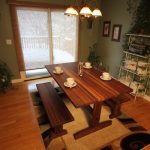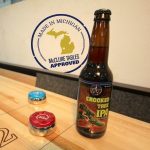
Hardwood Trees: Know Your Hardwood
Food and fire. Shade and shelter. Quality furniture and sturdy tools. Life without trees, especially hardwood trees, is unimaginable. Yet, when lost in the forest of ever growing uses for wood, it’s easy to lose the beauty of the trees themselves. The smell of the flowering fruit trees in spring and the change of colors in the fall. The least we could do to show our appreciation is to call a few of our favorites by name the next time we walk through a park or forest.
The Hardwood and the Soft
First, let’s sort out the hardwood trees from the soft. It’s pretty simple really, at least in Fall and Winter. Hardwood trees are deciduous, meaning they drop their leaves when the weather changes. Those pines and firs and cedars are lovely in Winter but they aren’t hardwood trees. In Spring and Summer, you can tell the hardwoods by their thin flat leaves and often by their flowers, fruits or nuts. Hardwoods are giving trees in more ways than one. So, let’s take a peak at the score card.
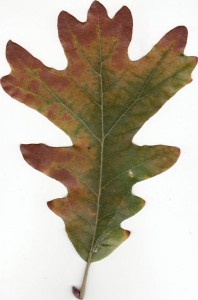
White Oak Leaf, a narrow hand with stubby fingers

Without competition for sunlight, this oak grew out in stead of up
White Oak
This is a big tree; 80 to 100 feet tall when mature and can be almost as wide. White oaks will grow taller in a forest setting where they are competing for sunlight but will be shorter and wider when planted alone. They are found mostly in the Northeastern U.S but can be found as far South as Florida and as far West as Texas. The bark is rough on mature trees and tends to be an ashy gray more than white. The acorns are smaller and sweeter than those produced other varieties of oak (of which there are dozens) and are favored by many birds, deer and other animals. The leaves are largish and look a bit like long hands with stubby fingers.
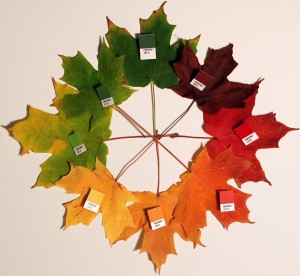
The sugar maple leaf is unrivaled for fall color
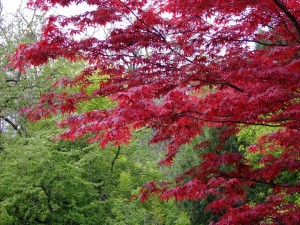
This Japanese Maple ALWAYS has red leaves
Sugar Maple – Rock Maple – Hard Maple
A Tree by Any Other Name . . .
When you think of a tree leaf you are probably thinking of a sugar maple. It’s the leaf on the Canadian flag and if you live in Canada or the North Eastern United States, it’s probably the leaf in your yard waiting to be raked. Hard Maple trees get to be about 100 feet tall and usually live two centuries or more. In the fall, rock maple leaves go through a series of color changes before they fall. It is not uncommon to see a tree sporting all its colors, from bright green to dark red, at the same time. Its fruit are double-sided seed pods that ‘helicopter’ to the ground in fall.
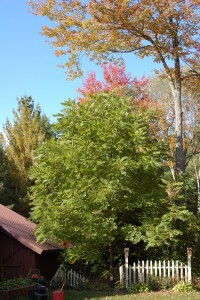
The Black Walnut tree secretes its own non-compete clause

Oval leaves and unripe fruit
Black Walnut
Black Walnut trees are grey-black and grow over 100 feet tall. They leaf late in the season, when all chance of frost is gone. When grown in an open area they tend to have shorter trunks and wide canopy. Unlike maples, which encourage smaller plants to grown in their shadows, walnut trees poison the soil around them inhibiting the growth of many plants including apples and tomatoes. Black Walnut trees favor slightly warmer climes than their hardwood brethren, showing up more frequently in the American South East and very rarely in the states along the Canadian border. Unlike many other hardwood trees, Black Walnut trees rarely live more than 150 years.
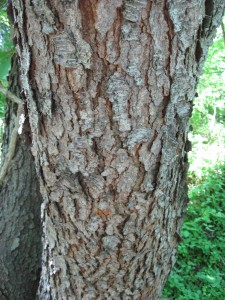
Fierce Bark . . .
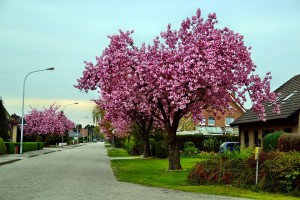
. . . and a bevy of blossoms
Black Cherry
Smaller than most of their hardwood cousins, Black Cherry Trees never get much over 80 feet and are usually much smaller. Like Black Walnut trees, they prefer to grow in open spaces. The bark of a mature Black Cherry tree is grey-black and chunky looking. They can grow in a variety of climes and soils. Black Cherry trees are found throughout North and South America. The leaves are roughly oval and two toned; dark glossy green on one side and a matted light green on the other. In the Spring, Black Cherry trees fill with small pink blossoms. As the blossoms fade the tree will fruit, filling up with bunches of dark red cherries.
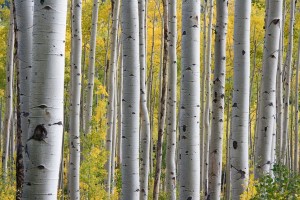
White Birch in spring
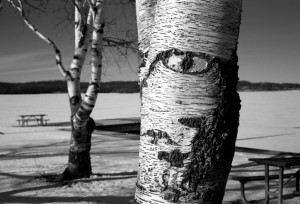
Here’s looking at you, kid.
White Birch
White Birch trees are smaller, slender trees, usually topping out at 60 feet, although they can get to be twice that height under the right conditions. They are less than 3 feet in diameter. The bark is thin and a very striking pure white with thin black scarring. The White Birch is a cold weather tree, found mostly in Alaska and throughout Canada, rarely venturing south of Michigan. With their 140 year maximum lifespan, they are the fashion models of the hardwood world, dying young but staying slender and beautiful until the end.
The above list is woefully incomplete. There simply isn’t enough room here for all, or even most of the large list of hardwood trees to be identified. There are 128 varieties of maple alone. Still, we needed to take a moment here to open the conversation, as it were, and to honor these plants that give us so much. Food. Fuel. Shelter. Decoration. Geological stability. Ecological stability. Even oxygen via photosynthesis. Take a moment to sing the praises of these not quite stationary statues and remember to count these among the giants on whose shoulders civilization stands.

White Birch Tree Tops against the night sky


